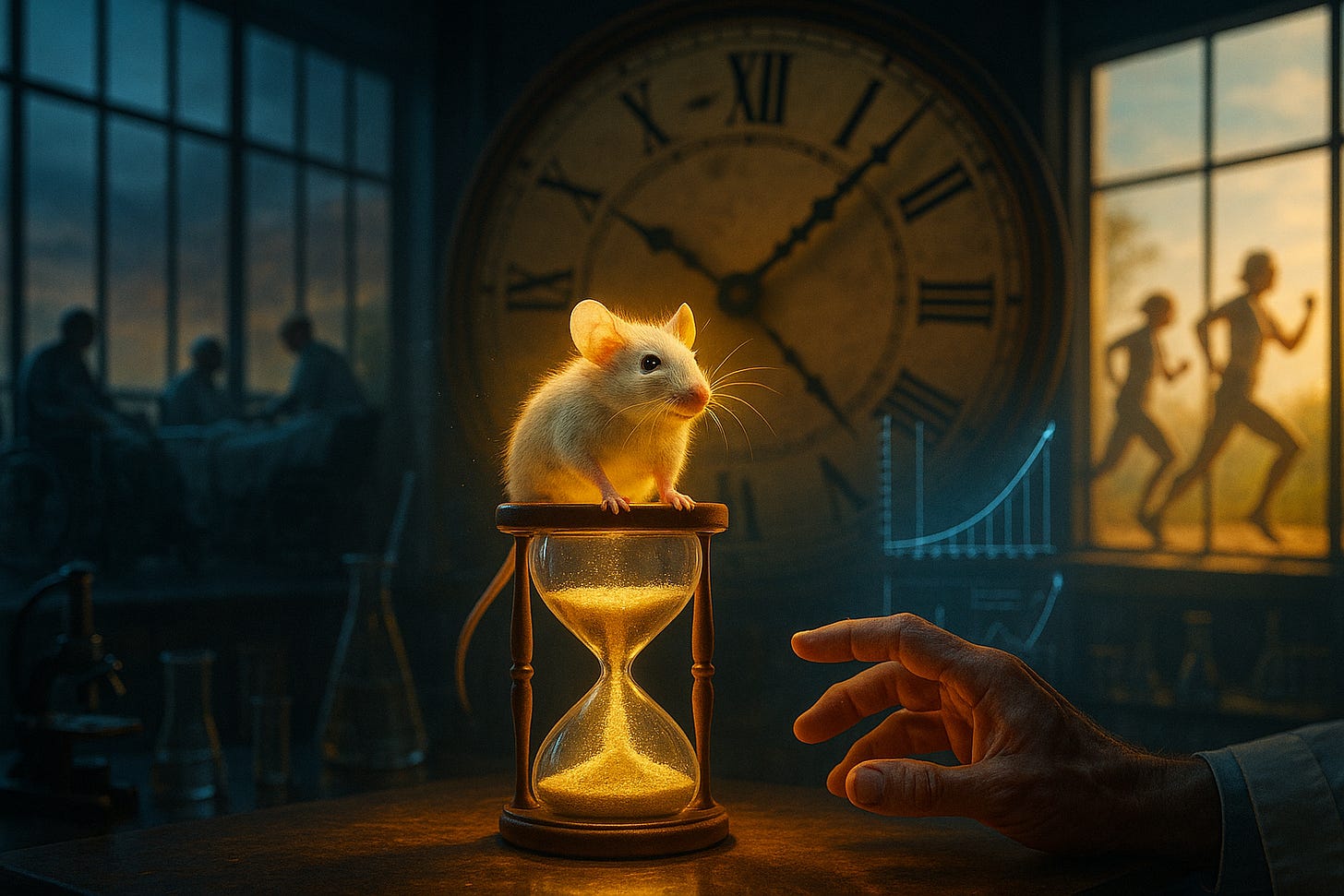The Mouse That Could Change Everything: Why Robust Mouse Rejuvenation Matters
We are on the cusp of a moment that will fundamentally alter humanity's relationship with aging. It won't come from a philosophical breakthrough or a cultural shift. It will come from a mouse—specifically, a mouse that lives twelve months longer than it should.
Let me explain why this matters more than you might think.
For the past two years, my LEV Foundation has been conducting the first in a series of studies that we call the Robust Mouse Rejuvenation program. We took 1,000 mice—500 male, 500 female—all 18 months old, which is roughly equivalent to a 55-year-old human. These mice normally live about 30 months, meaning they had roughly one year left when we began treatment.
Our goal is ambitious: extend their remaining lifespan by 12 months. That's not just a 50% increase in remaining life—it's the difference between incremental progress and genuine rejuvenation.
We didn't try one intervention. We tried four simultaneously: rapamycin (a calorie restriction “mimetic”), a senolytic drug to kill off senescent cells, gene therapy to restore telomerase activity, and bone marrow stem cell transplants from young donors. Each had shown individual promise in past studies published by others. The question was whether they would work together.
The study concluded in early 2025, and while formal analysis is still underway, the early signals are promising. The combination-treated mice significantly outlived their untreated counterparts, with some reaching ages rarely seen in this strain. The groups receiving all four treatments were among the longest-lived, suggesting the interventions were indeed additive or even synergistic.
But here's what makes this potentially historic: once we achieve that 12-month extension—once we double the remaining lifespan of middle-aged mice—we will have crossed a threshold that changes everything.
You see, no intervention to date has approached a full extra year of life in normal mice when started in middle age. Rapamycin might add 3-4 months. Other single interventions have typically added even less. So, 12 months starting at 18 months of age? That's unprecedented. That's proof that aging can be robustly postponed and partially reversed.
And I believe that, through how it is presented to the world, that proof will shatter what I call humanity's "pro-aging trance."
For decades, my colleagues in aging research have been terrified of making predictions about timelines. Ask any of them when we might achieve significant life extension in humans, and they'll change the subject faster than you can blink. They'll talk about progress and possibilities, but timeframes? Absolutely not.
This isn't because they don't have opinions. It's because they're afraid. They get their funding through peer review, where other scientists are forced to choose between competing grant applications with never enough money to go around. Those reviewers are constantly looking for reasons to say no. And a great reason to reject a grant? "This person said something irresponsible on television."
Whether or not making timeline predictions actually IS irresponsible doesn't matter. If it can be characterized as overpromising or getting the public's hopes up, that's ammunition for rejection. So my colleagues stay silent.
But robust mouse rejuvenation—achieving that 12-month extension—will eliminate that problem. It will make it safe for experts to finally talk about timeframes, because they'll have undeniable proof that dramatic life extension is possible.
I know these people well. There are literally less than a dozen of us who do frequent public outreach in this field. And I believe that if we achieve this milestone, they will finally feel comfortable making the kinds of predictions that will change public discourse overnight.
Once that happens, my job becomes much easier. These experts will influence the world's leading voices—the Joe Rogans, the Lex Fridmans, the Oprah Winfreys. And those influencers will demand action from their audiences. And then comes the last, most certain step: when the general public starts demanding something, elected representatives—whose primary goal is reelection—will deliver it.
We'll see an immediate cascade of demands for a proper COVID-scale war on aging. The kind of massive, coordinated effort that aging research has never received but desperately needs.
This is why the mouse matters so much. It's not just about proving that interventions can work together. It's about breaking through the communication barrier that has kept the public in the dark about what's really possible. I know that the public don’t care about mice - hell, I don’t care about mice either. But they are a means to an end: making aging the new COVID.
The interventions we used aren't exotic. Rapamycin is already approved for other uses. Senolytic drugs are in clinical trials. Gene therapy is becoming routine. Stem cell treatments are advancing rapidly. The tools exist. We just needed to prove they could work together to achieve something genuinely transformative.
We're planning our second study now—Study 2 will test eight interventions instead of four, using different combinations to push even further. But honestly, if Study 1 had already achieved what we hoped, Study 2 might happen in a very different world. A world where aging research finally gets the attention and resources it deserves.
The first mouse study took two years to complete. The formal analysis will take a few more months. But I believe we'll look back on that moment as the beginning of the end of aging as we know it.
Not because we solved aging in mice—though that would be remarkable—but because we finally gave humanity permission to believe that solving human aging is possible.
And belief, as it turns out, might be the most important intervention of all.
— Aubrey


